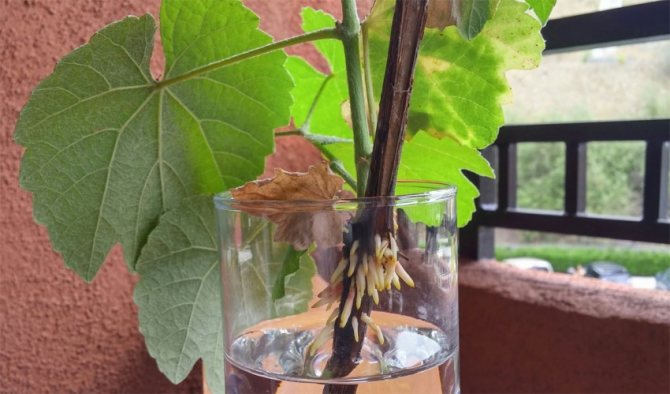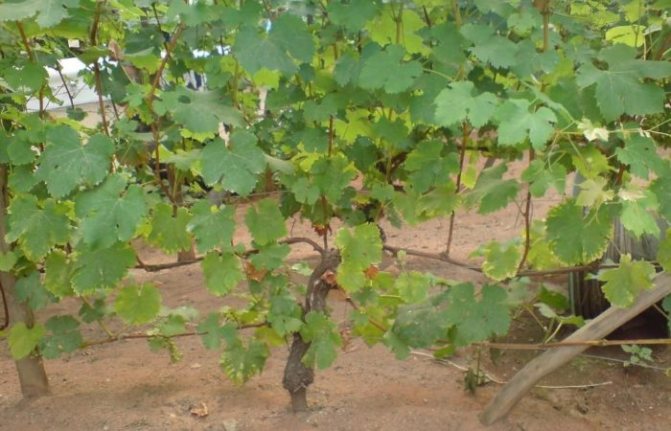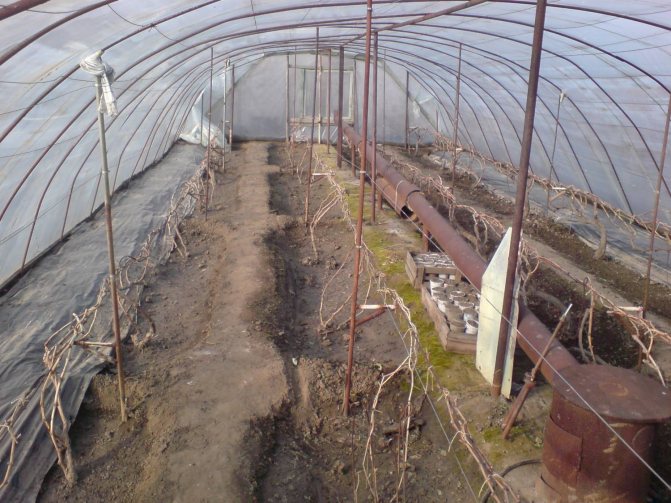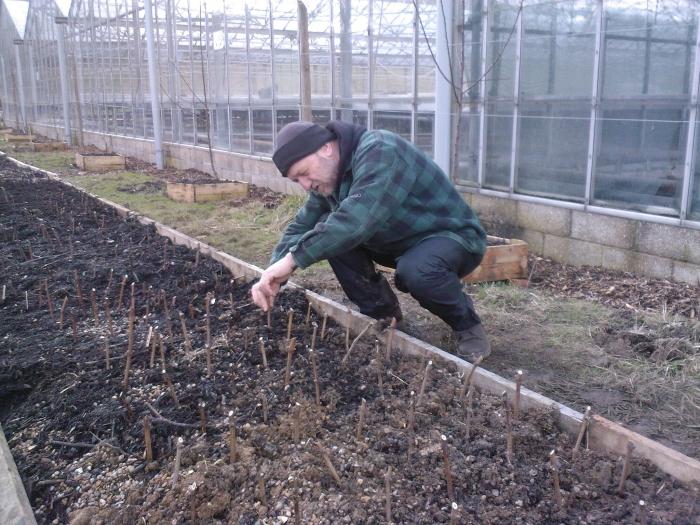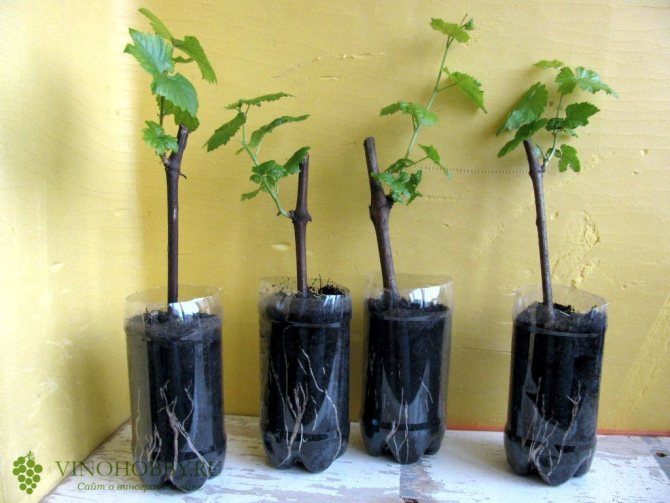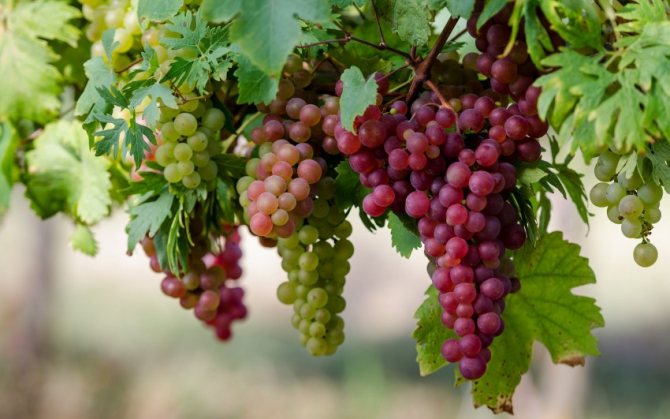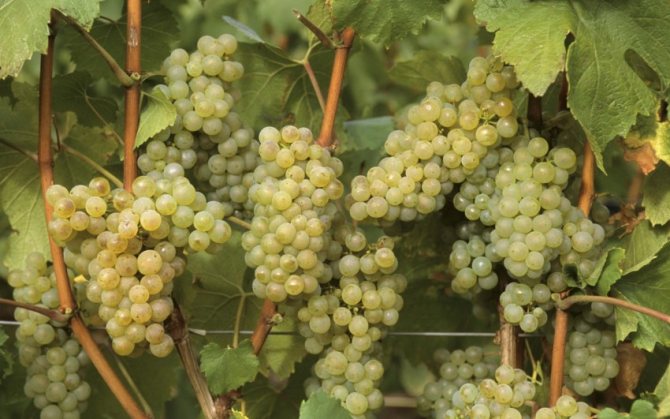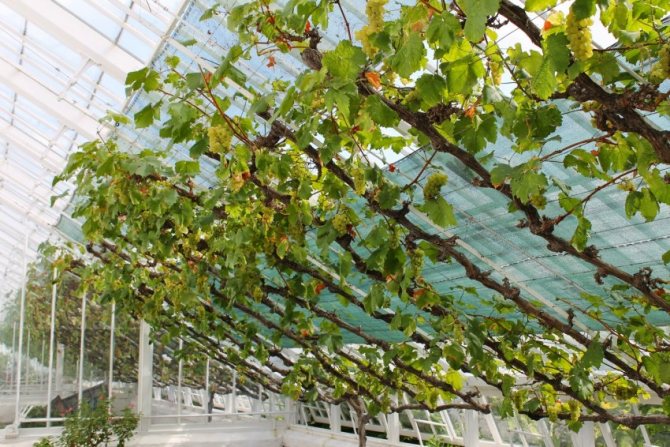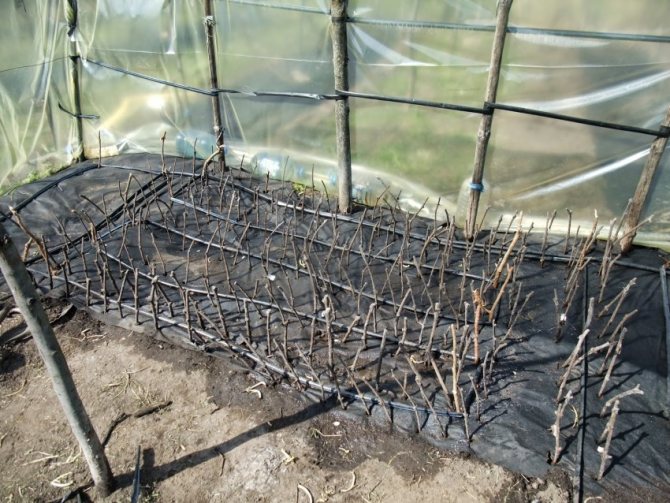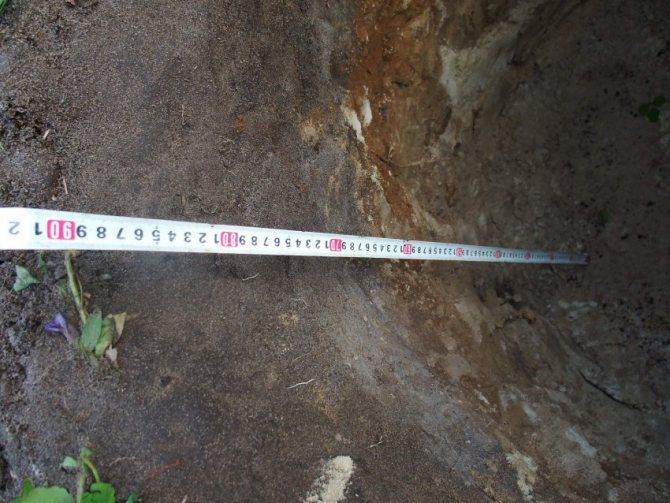The vine can bear fruit for up to 40 years. This requires proper care and proper pruning. Over time, the bushes age and the yield decreases - they have to be replaced. Industrial plantings over 10-12 years old are extremely rare - it is economically unprofitable to invest in an aging vineyard.
Summer residents show no less interest in purchasing grape seedlings. High-quality planting material from agricultural firms and breeding stations is not a cheap pleasure.
Buying seedlings on the market from random sellers is a game of "roulette": by its appearance it is not always possible to determine not only the variety, but even the type of grapes. There is little pleasant - instead of a dessert variety, purchase a decorative one with little edible fruits.
Is it possible to plant grapes by cuttings in autumn
In the fall, you can plant seedlings grown from grape cuttings. It is necessary to have time to plant the seedlings in the ground, two weeks before the first frost.
At this time, the earth has not yet had time to cool down; with a significant drop in temperature, the earth remains warm and will not allow young sprouts to freeze. For a long time their roots can bask in the warmth. The earth is in no hurry to give back the heat accumulated over the summer months.
When transferring a seedling from the container into the ground, a small part of the roots perishes. During growth, which continues in the fall, the plant regains lost roots. A well-rooted sprout will go away in the winter. With the onset of spring, he, along with the rest of the vines, will begin to grow at the right time.
Planting pits for grapes are prepared in advance, they are filled with fertilizers, fertile soil. After the seedling is planted in a permanent place, it is well spilled, after a while the root circle is mulched with humus, dry earth.
Hurry up! A significant cold snap, like freezing, gives a signal for the shelter of the vine in the winter. The seedling has a small sprout. That allows you to put it in a plastic bottle, after cutting off the bottom of it. Then cover it with soil, in a layer of 30 cm and put a pole to find it in the spring.
Questions from the mail
Marina, 42 years old, Tver.
Advise on the easiest way to propagate wild grapes at home. He is so beautiful at the neighbors' dacha both in summer and autumn.
Decorative wild or as it is also called "girlish" grapes take root without any stimulants with almost 100% probability.
- In May and early June, when last year's shoot began to grow, it is cut into shanks with 2-4 knots. It is best to choose areas where there are already rudiments of roots in the nodes (see photo).
- Practice has shown that it is most convenient to care for a seedling growing in an individual container. For the cutting of a girl's grape, this is a 1.0-1.5 liter pot.
- For rooting, a mixture of peat and sand is used in a ratio of 4: 1.
- In cuttings without leaves, the lower node or the entire "heel" with last year's wood is deepened.
A potted seedling can winter even under snow. They are planted in a permanent place by transshipment in the spring, before the leaves bloom.
Nikolay, 49 years old, Tambov.
I want to grow Isabella grapes for juice, wine, compotes. In our area, he hibernates without shelter.They advised to cut grape cuttings in the fall and root them. Can I plant cuttings directly into the ground?
Isabella grapes are an unusually hardy vine that is not afraid of frosts up to 30 degrees, does not get sick with traditional fungal diseases and, which is very important, tolerates waterlogging without the formation of foci of rot. This is the only mid-latitude grape variety that can be propagated by planting directly into the ground.
It is not necessary to count on a large yield of suitable seedlings (no more than 50%), but the lack of hassle with storage and rooting adds to the attractiveness of the autumn rooting method. When pruning a vine, there is plenty of cuttings material - planting can be planned "with a margin".
In order for the planted shanks to overwinter without problems, it is necessary to cover them with dry leaves, straw, spruce branches for the winter and cover them with burlap or spunbond.
Ruslan, 38 years old, Lipetsk.
Every year he sprouted autumn stems of grapes, everything turned out well. For the first time I decided to try to root green cuttings and nothing happened, although I did everything according to the rules
The technology of rooting green (summer) and autumn woody stems of grapes differs significantly. The main difference is the requirements for environmental humidity:
- autumn shanks require a minimum amount of water to form roots;
- green summer shanks evaporate water with their entire surface and constantly require moisture, which is difficult to control in summer.
The propagation of grapes by cuttings in the summer requires constant attention. Controlling temperature and humidity in a greenhouse-school takes a lot of time, even professional winegrowers prefer to harvest shanks in the fall.
Features of the choice of cutting
When purchasing cuttings, keep in mind that wherever you buy them, be it a store, nursery, market or buying in some other way. The very first step is to soak and disinfect the cuttings in a strong solution of potassium permanganate.
After processing, trim the cut a little and dip its upper part in the melted paraffin. The cut can be shortened by no more than 2 mm. Grapes often get sick, and even a stalk taken from friends, still treat it with a disinfectant for prevention.
Now you need to figure out what you should pay attention to when purchasing a stalk:
- there should be 2-3 eyes on the handle;
- the cut should be green, without mold, but slightly dried;
- the length of the handle is at least 10-15 cm.
It is desirable to have a tendril on the opposite side of the eye. The presence of a tendril tells you that there is a diaphragm that has plastic substances that promote root formation.
Kilchevanie grapes
Kilchevanie is the process of creating a temperature difference in the lower and upper parts of the shank: at the bottom - warm, at the top - cool. Kilchevaya increases the chance of rooting.
When germinating, the problem of bud germination arises earlier than the growth of roots. There are times when greens appear on a seedling and it, without having time to take root, is depleted and dies. It is kilchevnaya that can solve this problem. At home, in practice, it is carried out in the following ways:
- Containers with cuttings are placed on a battery or in a special kilchevate, for bottom heating (temperature from +20 to +27 degrees). The temperature in the upper part should be from +5 to +10 degrees. To create such conditions, the kilcher must be placed in a cool room. In the absence of a picker, the containers are kept on a battery, while a protective curtain-screen is constructed between the warm air of the room and the cool window;
- Upside down kilchevka gives high productivity. The moistened material is placed at the top, which is covered with a heated lid. This method does not allow the bud to bloom before the root system.
Preparing cuttings for planting
To increase the viability of the acquired cuttings, they must be soaked before planting. At room temperature, they are kept in water for 3 days. It must be borne in mind that dried specimens require more time to soak.
Order first! Good results are obtained by soaking the material in a heteroauxin solution. Cuttings treated in this way are planted in the ground on the same day. They are also soaked in a solution of aloe juice, honey, these are natural stimulants, they are usually used by experienced gardeners.
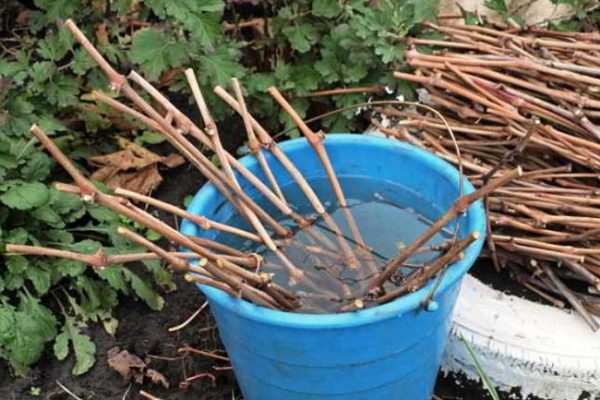
After treatment with stimulants, a furrow is made above the lower eye with a nail. Scissors scratch a 2-3 cm furrow. Wounds are applied to activate the cells, roots should appear at the site of the furrow.
While you were doing all these procedures, you should have made the kilchevators. They are done quite simply. It is necessary to purchase sawdust, prepare 2-liter plastic bottles.
Steam sawdust with boiling water, cool and disinfect with potassium permanganate solution, drain excess liquid. Cut off the tapered part of the bottle, drill a hole in the bottom to drain excess liquid. Fill the prepared container with cooled sawdust and place several cuttings there.
Most importantly, you need to find a suitable spot for the kilchevator. The most suitable place for him is at the battery under the window. At the bottom, it should hit + 25 ° C, at the top by 5 ° C less.
In a moist substance and at this temperature, after 3 weeks, roots will appear on the cuttings. During the same time, the leaves will hatch. Pay attention, the roots appear first, then the leaves.
To check the appearance of roots. The bottle will have to be cut, otherwise you will see them. The rooted cuttings are removed, the bottle is glued together with tape and the unrooted specimens are again placed there.
Attention! Rooted cuttings are planted in pots with nutrient soil mixed with sand, for drainage, coarse sand is poured at the bottom of the pot. Drainage for grapes is required, he does not like stagnant water.
Preparation of shanks
It is recommended to harvest cuttings from mid-autumn and no later than the first day of winter. The diameter of the scion should be at least a centimeter, and no more than eight, but not less than four buds should be located on it. The cut is best done obliquely. When choosing, it is also important to be guided by the length of the shoot - the larger it is, the better. Learn about the Gurzuf pink grapes at this link.
Before planting, the shanks should be soaked in clean water (preferably thawed) for two to three days. If planting is not planned in the near future, you can carry out the processing with potassium permanganate, wrap it with foil and send it to the cellar for storage.
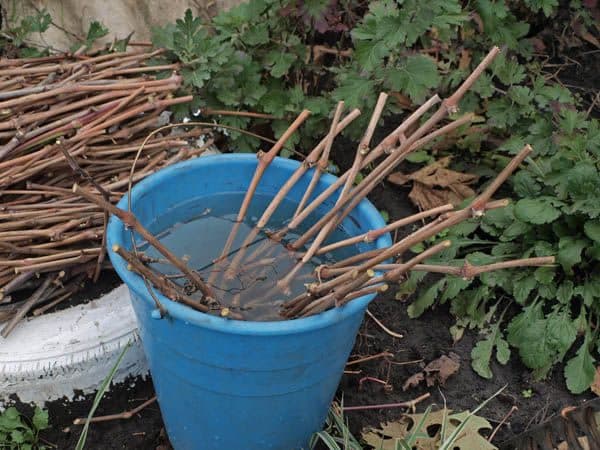

If it is not possible to prepare your cuttings due to lack of time or the vineyard itself, there is always the opportunity to buy them in the spring at specialized sites.
Characteristics of the soil for planting
Before you start planting grape cuttings, decide on a place. On an area with a steep slope to the northwest or north, you should not plant grapes. Salt marshes and wetlands are not suitable for growing vines.
We decided on the place, start preparing the soil. This should be started in the summer. The future planting site for seedlings is cleared of debris and weeds, and shovels are dug to the depth of a bayonet.
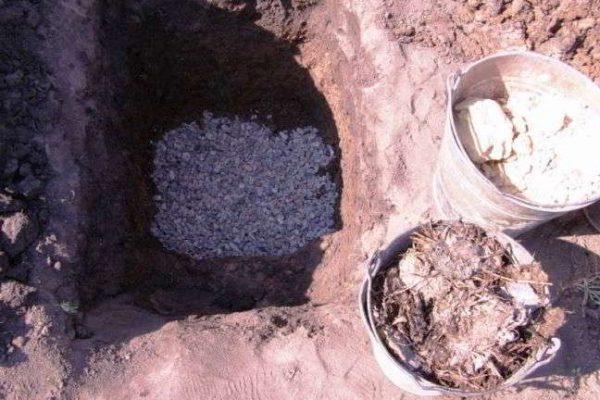

The site is left alone until the next time. The land on the site should remain clean and loose during the entire time before planting.
The most desirable fine lumpy soil structure for grapes. The optimal ratio of thermal, water and air conditions makes it ideal for the growth and fruiting of the vine.
The coarse-lumpy soil structure slows down the development of the seedling. Fruiting on such soils occurs much faster.The vine forms a bunch of small berries, very sweet, but very little acid.
Unsuitable for vines is floating soil, that is, alluvial soil. Such soil is usually in low areas, where water often stagnates. Grapes in such places usually become smaller and die.
The need for germination
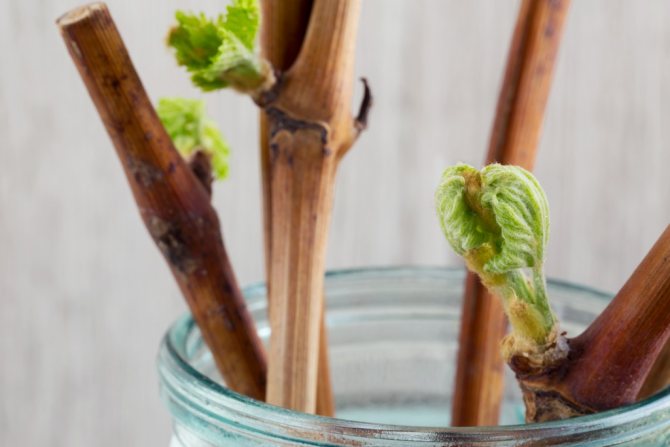

For the propagation of grape bushes, germination of seeds, rooting of cuttings or cuttings, planting of ready-made seedlings are used. The seed method of growing is very rarely used. It takes a lot of time to get the finished plant. At the same time, many young plants die or do not retain varietal characteristics. Ready-made seedlings are good because they allow you to immediately get a ready-made young plant. But the purchase of seedlings always turns out to be significant costs.
Most often, cuttings or rooting of grapes by layering are used for home breeding of the varieties you like. In this case, the use of a particular option is determined by the weather and climatic conditions of the region where the plants are grown. If warm weather sets in early and is not limited to one summer month, cuttings rooting are used. In all other cases, cultivation with cuttings or shanks is recommended.
Important! Cuttings are the preferred method of growing grapes in northern regions with short summers, few sunny days and a high risk of recurrent frost.
Benefits of growing grape vines by cuttings:
- A young fruiting vine is used for cutting cuttings.
- Any varieties are suitable for grafting.
- To obtain a high-class planting material, the cut planting material is prepared in a certain way. Rooting is carried out so that the cuttings give roots by the time of transplantation to a permanent site.
- The transplanting of a planting material adapted to the conditions of the site is faster than the rooting of cuttings.
Before planting in a place of constant growth, the harvested shanks must be germinated. Only then can you get a healthy, strong bush, which will be well accepted in a short time, give foliage and withstand diseases.
Harvesting and storage of cuttings
Time is running out! The paramount condition when cutting cuttings in the fall is to harvest them from 100% healthy vines. Any mechanical damage to the material is not allowed.
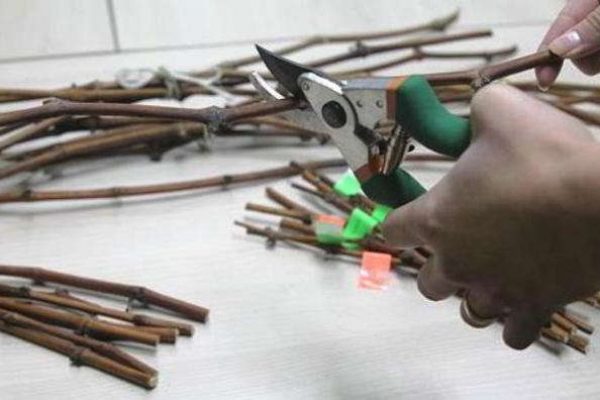

Pruning of vines and harvesting of cuttings are carried out at the same time. The time of its holding is the beginning of September, if you did not manage to prepare it, you can do it in the middle of the month. In southern Russia, this operation is carried out in mid-October, where frosts start late.
Visually, choose powerful, healthy shoots, it is better to look after those that bring full-bodied bunches and are adapted to local climatic conditions. A prerequisite for harvesting cuttings, the vine must be fully ripe.
Experienced growers can sense the required qualities by touch. The vine has the color of stale straw, it is immediately visible among the young growth. These are signs for experienced gardeners. These signs will be understood by novice gardeners:
- Dip the cut of the harvested vine in a solution of 1% iodine, if it becomes dark purple - this vine is suitable for cuttings.
- The harvesting of the vine, or rather its cut remained light green, then this is not a suitable vine.
- After culling unsuitable vines in maturity, it's time to start harvesting cuttings. In this case, it is necessary to take into account the necessary requirements for the harvested material:
- The diameter of the workpiece should be 6-7 mm (exceptions are allowed only for varieties with thin vines).
- Cuttings harvested in autumn should be at least 65-70 cm long. During storage, they dry out, in the future the sections will have to be updated.
- Leaves, stepchildren antennae are carefully removed from the blanks and tied into bundles for further storage (hang a tag with the name of the variety on each bundle).
Create conditions! The most important stage remains, storage of cuttings.A large number of cuttings are usually stored in prepared trenches, covered with soil 25 cm thick. This storage method is preferred by nurseries and farms selling planting material.
For summer residents, storing cuttings in cellars or basements is quite suitable. The air temperature in the room should be from 0 to + 4˚С, humidity not more than 60%, otherwise rotting of the workpieces cannot be avoided.
Before storing:
- the cuttings are saturated with moisture, the lower cut is placed in water for a day;
- disinfected by immersing the planting material in a 3% solution of copper sulfate, this will protect it from mold and give protection from dampness.
If you have very few blanks, then you can save them in a box with sand, keeping the storage temperature + 4 ° C, not forgetting to moisten the sand, in order to avoid drying the cuttings.
To preserve the blanks, it is necessary to conduct an audit once a month, and remove the copies you do not like during inspection. Let there be fewer of them, but they will remain healthy. Potassium permanganate easily fights mold, if it appears, rinse the blanks in a solution and dry. But do not leave rotten cuttings, throw them away without regret.
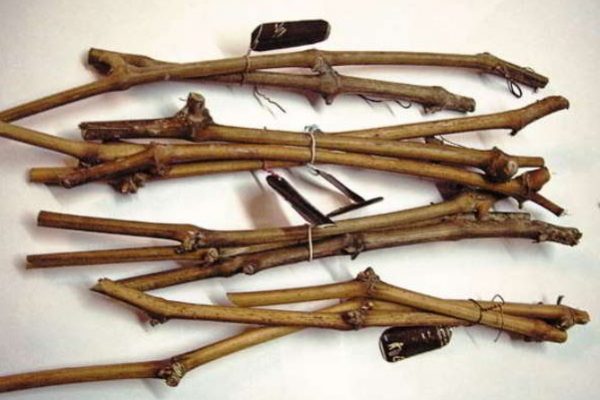

A little theory, which an ordinary summer resident cannot do without
All the rules for cutting vines for harvesting shanks have a scientific background. Without a clear understanding of the structure of the vine, cutting cuttings turns into a set of sequential monotonous actions to fulfill strict and completely incomprehensible requirements.
All operations for harvesting grape cuttings will seem simple and straightforward if you understand the structure of a piece of vine. Nodes and internodes - the whole vine of grapes consists of them.
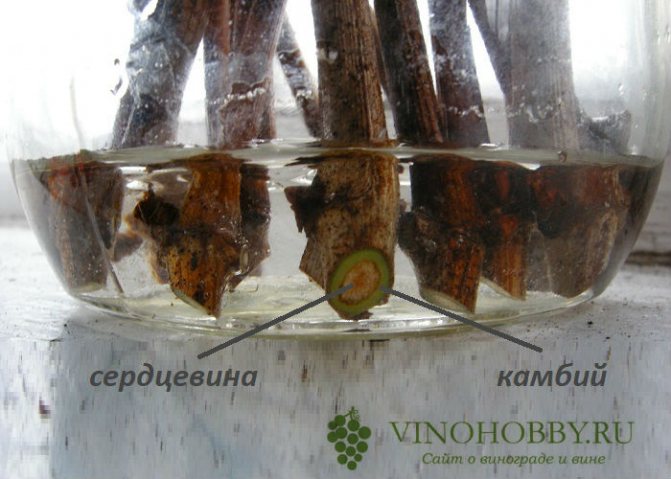

Easiest with internodes... Their main purpose is the transit of nutrients and water, by analogy with human blood vessels. The outer cover (bark) protects the wood from damage and moisture loss. Under the bark is cambium, a thin layer of tissue responsible for regeneration processes. If we continue to draw analogies with the human body, cambium is an analogue of stem cells, which, under certain conditions, give rise to any organ. In the case of grape propagation, it is the cambium cells that develop into the root system of the seedling.
For the successful transformation of cambial tissues, a supply of nutrients and moisture is required. IN core carbohydrates are deposited, which support vital processes during winter storage, and nourish growth processes during rooting.
The second mandatory component responsible for metabolic processes is water. The distribution of water reserves in the vine (and cuttings) depends on the nodes, which can be simply described as an ordinary membrane.
There are 2 types of nodes (see picture):
- The core channel is largely blocked - the outflow of nutrients is significantly slowed down. Most knots on vines are of this type. They are responsible for the outflow of nutrients at the end of the season from the leaves to the root and arms.
- The internode forms an almost deaf membrane, which delays the flow of water and nutrients as much as possible. Type 2 nodes on the vine are easy to find - just find tendril knot.
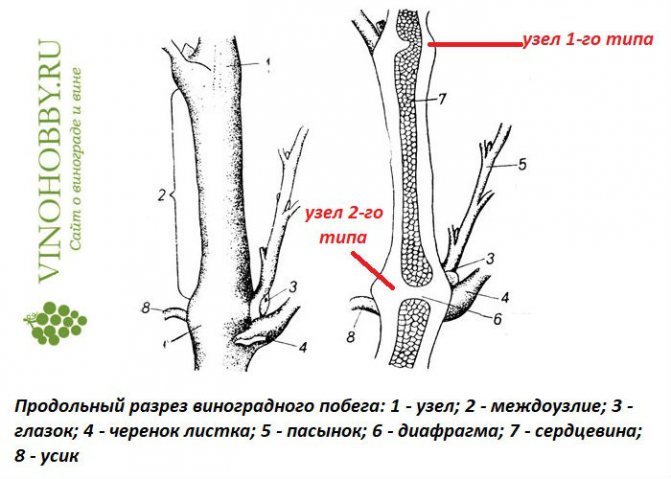

The most promising units for the preparation of shanks easy to determine "by eye":
- evaluate the difference in the thickness of the vine and the diameter of the node and choose a section of the vine according to the principle "the thicker the node, the stronger the growth bud";
- for the lower (calcaneal, root) part of the cutting, choose nodes with the remains of the antennae, that is, with a developed internal septum.
After such a "lyrical digression" questions about the rules for cutting cuttings should remain much less.
How to plant cuttings in autumn
It is not recommended to plant cuttings in the soil in the fall, planting can be carried out if you have any unforeseen circumstances that prevented this from being done in the spring.Cuttings planted in the fall will need to create significant insulation.
Get started! The best time to plant cuttings is October, but better be guided by the weather and its forecast. Planting must have been done a month before the temperature below zero. Cuttings and seedlings of grapes are planted in the fall, and those who do not have the opportunity to plant them in the spring
Cutting grape blanks
In order for rooted grapes to take root faster, you can resort to grafting technology. You will need containers for future seedlings (halves of plastic bottles) and a substrate. The latter consists of humus, sand and sawdust mixed in equal proportions. The substrate should be loose and damp with drainage holes.
When propagating grapes with green cuttings, you need to water it three times every week. If vigorous growth is observed, adjust by pinching. The very process of planting grapes in spring is carried out at a temperature of 2-5 ° C. We will tell you how to plant cuttings, step by step:
- Cut the workpiece on both sides.
- Make a groove (with a sewing needle, make longitudinal scratches on the bark).
- Leave the workpieces in water for 2-3 days.
- The soaked blanks are transferred to a root-forming stimulant.
- Fill the prepared containers with water, put the cuttings there and keep in the sun for about a month. The buds will appear in 15 days, the roots in 25-28.
- After waiting for the grapes to germinate at home, fill the container with a drainage layer. Layer thickness - 2-4 cm.
- Lay earth (5-8 centimeters) on top of the drainage, place a shank and add some more earth. Make sure only the tip of the shoot sticks out of the soil.
- Expose the cutting to the sun and water it continuously. When the shanks are planted, wood ash and potash fertilizers are allowed.
Usually, grape cuttings are harvested in the autumn, when the plant needs pruning.


Harvesting cuttings
Do not throw away all the pruned branches - this is a valuable material for the propagation of the vine. The branch should be lively, with a light-colored bark, the absence of any painful spots, dry areas and damage, even not large, is obligatory.
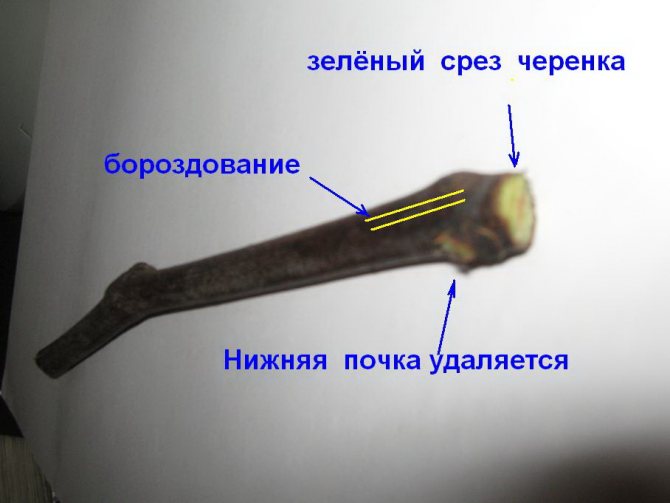

Cutting preparation - scheme
Next, we process the selected branch, cut off all the leaves and shoots from it, the upper tip must also be trimmed. As a result, a not very thin twig should turn out, the diameter of which is about 1-1.2 cm, and its length should be from 30 to 45 cm. Several developed buds must be visible on the vine. Pruning is done with a sharp pruner or knife, the less the twig is crumpled on the cut, the better.
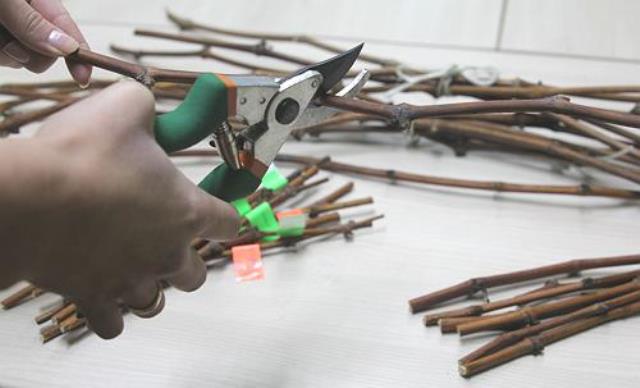

Slicing grape cuttings
If it is not possible to prepare your cuttings due to lack of time or the vineyard itself, there is always the opportunity to buy them in the spring at specialized sites, but in such cases there is a considerable danger that the variety on the label does not correspond to the actual one. When buying, you should pay attention to the conditions where cuttings and seedlings are stored by sellers, if it is a dry and cold room, it is quite possible that they are already spoiled. When purchasing a seedling, it is worth looking at the roots, they should be in wet soil and not dry.
Harvesting cuttings
How to plant cuttings without roots in the ground
In this case, they dig a trench with a bayonet width of a shovel, the depth is the same, it can be a little deeper. A bucket of humus is consumed per meter of the trench. They loosen it with one more bayonet and cover it with soil.
The cuttings are stuck into the ditch at a distance of 15 cm at the end of the work, and the trench is shed with water. Planting cuttings in the school is carried out with a slope to the south. The remoteness of the rows should be at least 40 cm. Loosening and weeding of seedlings in the future should not cause inconvenience to people working here.
A specially designated area of land for growing seedlings from cuttings is called a shkolka.
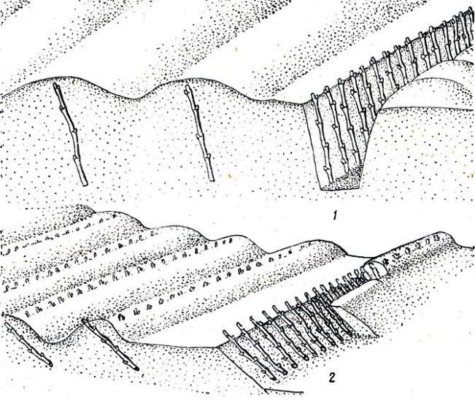

school for planting grape cuttings
At the end of the disembarkation of the blanks, arches of at least 40 cm are placed above each row and polyethylene shelters are pulled from above. It will protect the cuttings from wind and frost.


In the spring, with the onset of positive temperatures during the day, the shelter must be opened to air the plantings. With the onset of a constant positive temperature, the planting completely eliminates the need for shelter.
You can plant cuttings in a different way, this method is more suitable for home gardens. I plant two cuttings in pre-prepared planting pits, in case one of them does not give roots. If both take root, just sit them down. Plant the stalk 2-3 buds deep, that is, they should be immersed in the soil, and only one remains above it.
The planting shelter is made with earth, covering it with a layer of up to half a meter. Combined backfilling with layers is also allowed:
- loose earth (25 cm);
- foliage (12 cm);
- soil (25 cm).
Insulate! In the spring, the bulk is removed, a temporary greenhouse is erected in its place, not forgetting to ventilate and accustom the planting to the environment from time to time.
Methodology
It is important that the root callus is formed before the swelling of the kidneys.
Gardeners are constantly racking their brains over how to propagate grapes with cuttings and preserve rooted shoots.
For this, different methods are used:
- Plastic bottle technique. The bottom of the shank is wrapped with foil and a damp cloth, the top - only with foil. Multi-temperature bottles are pressed against the container.
- Pusenko's method. The tops of the shanks are not wrapped, and germination is carried out on the cupboard. The fabric is periodically moisturized.
- Radchevsky's way. This specialist advises to plant the workpieces in containers, and then use boiled (rain) water. Polyethylene retains moisture, and the container itself is exposed to the southern window of your home.
- Electric heating kilchevanie. It is recommended to plant grapes by cuttings in a box. The heat is generated by the appliance (aquarium heater).
- Sprouting in sawdust. Sawdust is poured into the container, and boiling water is added there. The cuttings are kept in a container with film and sawdust (the latter are continually moistened).
The quality of rooting, the vitality of the grapes and the future harvest will depend on how much the preparation and planting will be done.
Seat selection
The landing site should be well lit and located on a small hill. In the lowlands, moisture will accumulate, which can cause cultural diseases. In this case, the soil should be well drained with pebbles or artificial drainage. It is best to locate vineyards on the south or southwest side.


Yield, speed of development and longevity of plants depend on choosing the right place for planting.
For the first time, fertilizers are recommended to be applied in the fall during the initial preparation of the soil. In this case, it is possible to add mullein to the soil. Further, a complex mineral fertilizer (potassium salts, superphosphates, nitrogen supplements) is useful to lay out on the bottom of the hole when planting. With such a feeding, the plants will have enough food for three to four years.
How to plant cuttings in sand in spring
Rooting cuttings in the sand in early spring in greenhouses, hotbeds and at home significantly increases the growing season. This method is suitable for central Russia and the Urals, the summer in these regions is short and the grapes often simply do not have time to go through the entire cycle in such a short period. Forcing seedlings in greenhouses takes 3 months.


The vine is harvested for cuttings in October, it must be ripe, then the seedlings will turn out to be strong.
Before planting, the cuttings are soaked in potassium permanganate, then you can continue in a solution of honey for a day. Cuttings treated in this way are planted in sand for germination.
Containers with sand must have holes to drain excess water. Racks with seedlings should be heated, the bottom of the container with a seedling should be warmed up by 2 degrees above the environment. The air temperature in the greenhouse should be kept at + 20˚С.
It will be possible to transplant seedlings with roots of at least 3-4 cm into the nutrient medium. Before transplanting, it is advisable to treat the soil with fungicides. Watch the video how easy it is to grow grape seedlings from cuttings at home.
What to do with green cuttings
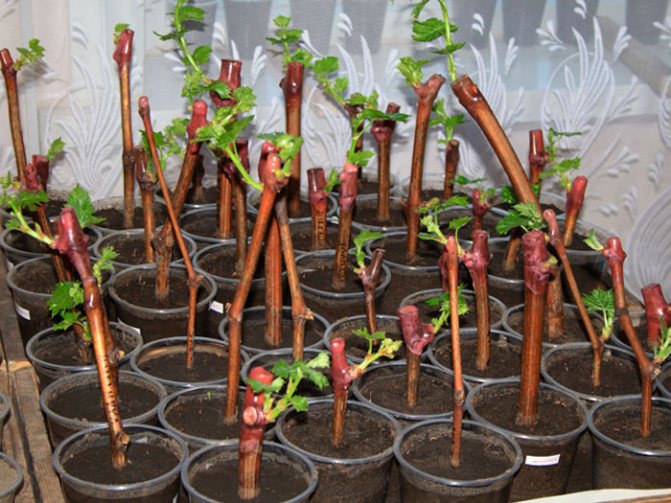

The propagation procedure with green cuttings is recommended in the summer according to Lykov's method. Eye cuttings are cut from ordinary shoots or stepchildren. The workpieces are placed in a bowl filled with rainwater. The capacity is a five-liter jar with drainage holes, filled with "mole" earth.
The seedlings must be constantly shaken and watered. One five-liter bottle can accommodate up to four seedlings, fixed at a depth of about 5 centimeters. Build a wooden frame around the can and wrap it with plastic.
Most of the methods described above are applied in early spring. Green cuttings are done in mid-June, and the germinated seedlings are moved outdoors in August. Feed the cuttings with Ridomil Gold. And enjoy the feeling of a job well done.
Features of planting cuttings in the fall
We must hurry! In autumn, grapes are planted from the first days of October until the ground freezes. The planting principle is the same as in the spring, in the fall it is required to cover the seedlings until frost. You have already learned how to cover.
The seedlings are still quite tender and they cannot survive the frosts, which means they must be very carefully covered. Only healthy and strong specimens are chosen for planting in the ground. If they can withstand the winter, then in 3 years you will have powerful bushes with strong vines.
Usually in the garden plots for growing seedlings in the summer they dig holes, prepare an earthen mixture and plant 2 cuttings in one hole. This is done for insurance, if one of the cuttings does not give roots. If both are rooted, you will receive an additional seedling.
You can, of course, put in a school, but it will be much more troublesome. It is necessary to dig a trench, charge with humus, mix, the soil for planting must be loose. Plant the cuttings in it, then you need to build a shelter from the wind and frost.
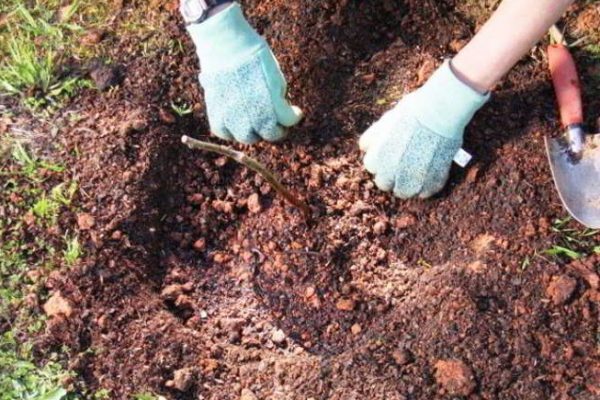

Procurement of material for planting
For germination in the winter-spring period, cuttings are selected from a matured (brown, crackling when bent, lignified) annual vine. They are harvested when pruning grape bushes (approximately October, before the onset of the first frost). In non-covering zones, the shanks are cut off for reproduction at the end of November and in winter - from the vine, without any symptoms of drying out or freezing.
Breeding material is best obtained from the healthiest and most productive bushes that have typical varietal characteristics. These are bushes with even branches, without defects and spots. For grafting, the middle part of the shoots is selected, which germinated from the central buds of two-year-old branches.
The normal thickness for cuttings is considered to be from 0.5 to 1 centimeter (for a variety that has a thin vine, this rate may be lower). Fatty and thick stems have loose wood, so they are not suitable for reproduction.
Planting cuttings in autumn in Moscow
The planting of grape shanks in the fall in Moscow and the Moscow region is done, as well as in the spring. For viticulture, this region is considered a northern region and special early maturing varieties are needed here.
Most of the early and very early varieties of the European collection were created for covering viticulture in the southern regions. Such varieties are not suitable for the Moscow region. To lay buds, grapes require a temperature of +25 to + 35˚С, and in the Moscow region in July the average statistic is only + 18˚С; night and day + 21 + 23˚С.
Take your pick! Fortunately, the extra early varieties bred by local amateur breeders, which have excellent taste, are not inferior in anything to the varieties of Europe, help out. Their vegetation takes only 110 days, and the temperature is quite suitable in the Moscow region.
Let me introduce the best varieties for this region:
- Russian corinka and decorative.
- Queen of the vineyards and Muromets.
- Frankenthal and Early North.
- Krasa Dona and Russian early.
- Aleshenkin and Michurinsky.
Here are how many varieties for cultivating excellent grapes in this "northern" region by the standards of Europe. You can buy the listed varieties from the aces of viticulture. At experimental stations and horticultural reference points.
Chubuki can be stored in plastic bags filled with steamed sawdust or sand. In March, you will need to get the cuttings purchased in the fall and germinate them, plant them in a permanent place in the spring. You have already familiarized yourself with the technology of preparing cuttings for germination, so you should not repeat the same thing several times.
The only thing you need to focus on is that the cuttings need to be watered and sprayed every day. The plant loves water, but does not tolerate stagnant water. Don't forget the holes for the excess fluid to drain.
After the stems acquire roots, they should be transplanted into nutrient soil, consisting of sand and peat in equal proportions. It doesn't matter what container to transplant, to save money, you can transplant it into the same packages.
Provide light and warmth for sprouted seedlings. Start feeding, already in the first week, feed with a weak solution of complete mineral fertilizer.
Prepare! In the Moscow region, a special composition of the soil is combined for grapes, unfortunately, without this, good grapes cannot be grown.
To prepare a loose and permeable soil structure, mix in equal parts:
- loamy and clayey soils;
- sand and broken brick;
- humus and gravel;
- superphosphate and ash are added;
- bone meal and crushed bones.
From the resulting substrate, ridges are then made, 35 cm high and 1 m wide.Then the seedlings are planted to a depth of 20 cm, the distance to their honey should be about a meter, no more than 1.5-2 meters between rows, this is due to the climatic conditions of the region. The care and formation of the bush, the rationing of the crop with such a planting scheme is much more comfortable.
Growing seedlings
Cuttings with barely visible roots up to 5 mm should be planted in the ground, cups or cut PET bottles are suitable.
Planting cuttings
It is better to prepare containers and soil for germinating cuttings in advance, so that when roots appear, plant the shanks for rooting immediately. The soil requirements for rooting cuttings should be considered as a separate item in order to avoid typical mistakes.


The soil
When growing seedlings (or seedlings from seeds), the main task is to create conditions for good root growth. The rapid survival of the seedling in a permanent place and its entire subsequent growth depends on the development of the root system. With the best of intentions, gardeners give the most fertilized soil and thus render a disservice: with an excess of nutrients, the roots hardly grow, since they have no need to penetrate the volume of the soil in search of everything they need.
For germinating cuttings, it is best to use loose soil with a moderate amount of organic matter., in equal parts:
- sand,
- garden land,
- mature humus or compost.
The mixture is prepared at optimum humidity. Use the rule: the soil, compressed in the hand, forms a lump and does not stain the palm. It is this state of the soil that should be adhered to, and not overmoistened in any case.
You should be prepared for the fact that the roots of even shanks of the same variety will not hatch at the same time.
Planting shanks
Disposable plastic cups with a capacity of 0.5 liters look neat and cute, but their volume is not enough for the development of the root system of the seedling. For planting grape cuttings for rooting, larger containers are required - approximately 1 liter.
Cut PET water bottles work well for this purpose.
- It is convenient to use bottles with a volume of 1.5 liters without a neck, their capacity is just a little more than 1 liter.
- Stagnation of water is categorically contraindicated, therefore drainage holes are required.
- To avoid stagnation of water, drainage is laid at the bottom. You can use a layer of expanded clay, pebbles, crushed stone, etc.
- To prevent the top layer of soil from clogging the drainage channels, a piece of agrofibre is laid on top of the expanded clay.
- Pour 2-3 cm of prepared soil.
- A stalk is installed and gradually gently fill the container with loose soil, shaking slightly to compact.
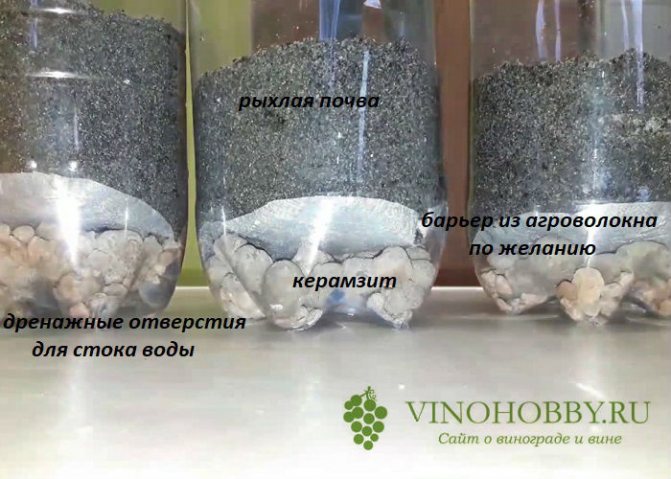

As a result, the cutting should be buried 10-12 cm into the soil. It is watered and placed in a well-lit place.
Treatment of grapes with remedies from a home first aid kit
Have you treated plants with iodine? I didn't have to! But in the treatment of grapes, iodine is often used and not only for treatment, but also as a prophylactic agent.
In cool and rainy summers, the grapes are infected with mildew and whatever the disease is allowed, the vines are sprayed with a solution of iodine. If you do not spray, you will have to, then fight the disease with the help of chemistry, which will not benefit the bunches, and your body.
Take note! Iodine is useful for grapes, it enriches the berries with itself, and their taste only benefits from this. Many foods that are consumed by humans contain very small amounts of iodine, its deficiency badly affects your well-being.
Still, you should not overdo it with spraying the plants with its solution, the grapes will not get the benefit from such care. With an excess of iodine, grapes will significantly slow down growth. Please note! In everything, one must observe the measure.
A prophylactic solution for mildew is prepared as follows:
- 1 liter of milk;
- 19 drops of iodine;
- 9 tablets of Trichopolum;
- 9 liters of water.
Mix all the components and spray the grape bushes with this solution every 11 days.
Don't forget about baking soda. Its solution rejuvenates plants, fights diseases. Spraying the vines during the ripening of the bunches increases the sugar content of the berries. In addition, a side effect has been noticed, do not worry, it is positive, weeds disappear in the near-trunk circle. Here are some recipes for treating grapes with soda.
Soda from oidium
Dissolve 4 tsp in a bucket of water. baking soda, 19 gr. soap, it is better for children, mix well. Spray before flowering, then at weekly intervals, 3 more times.
Treatment of grapes from gray rot
Apply the composition in case of weak damage to the plant. Take 70 grams per bucket of water. soda, spray the bushes with this solution.
Add 2 tsp in a liter of water. soda, vegetable oil, dishwashing detergent, stir and spray with a spray bottle in dry, cloudy weather.
It will come in handy! These simple techniques are very effective in combating many diseases of grapes, they should be adopted by gardeners. Who needs bunches stuffed with chemistry on their own table?
For personal use, deal with chemicals as little as possible. Take, into service with simple affordable drugs from the home first aid kit.
Care
Caring for grape plants is within the power of both a professional and a beginner.
Young plants of the varieties Laura, Merlot and others need high-quality and regular watering. In the spring, it must be carried out as the soil dries out. The last procedure before flowering should be carried out no later than a week. Further watering the vine will be required only after its completion.


Water the cuttings with warm water.
Top dressing
As noted above, the vine does not need frequent feeding.If fertilizers were applied in the fall or spring before planting, you will need to feed the bushes a second time only on the day of this procedure. The next top dressing will be needed only after three to four years, when the soil is depleted. Learn about the cultivation and care of the Galahad grape variety from this material.
What do the experts recommend?
- Planting material is taken exclusively from a culture that grows in a climate that belongs to the gardener's site. If you take a foreign material, it will spend a lot of time settling in a new climate and may die.
- The shanks cut in early spring take root much better than autumn ones, so if there is an opportunity to carry out the procedure in spring, this will be the best option.
- Exceptionally healthy mother material is selected for cutting cuttings. If the grapes are sick or very old, there will be little sense from such cuttings. But it shouldn't be a young vine either. Ideally, when bent, it should emit a characteristic crunch.
- If several varieties of grapes are cut for winter storage, it is imperative to mark them or put them in separate bags, otherwise in the spring there will probably be problems with the identification of species.
rules
In mid-April or early May, when the soil warms up to a temperature of at least ten degrees, the rooted shafts are planted in open ground. The site for planting grapes should be well lit by the sun, without a close occurrence of groundwater and protected from strong winds. Before planting seedlings, the area must be free of weeds, dig up and prepare planting holes in advance. It is advisable to dig the grooves for laying the shanks according to the markings, which can be drawn using a rope and a peg. When the grapes grow a little, it will be much easier to put up the support posts and pull the wire. Only those seedlings that are not damaged should be planted in open ground. With well-developed eyes and roots. After planting, the plants need abundant watering.
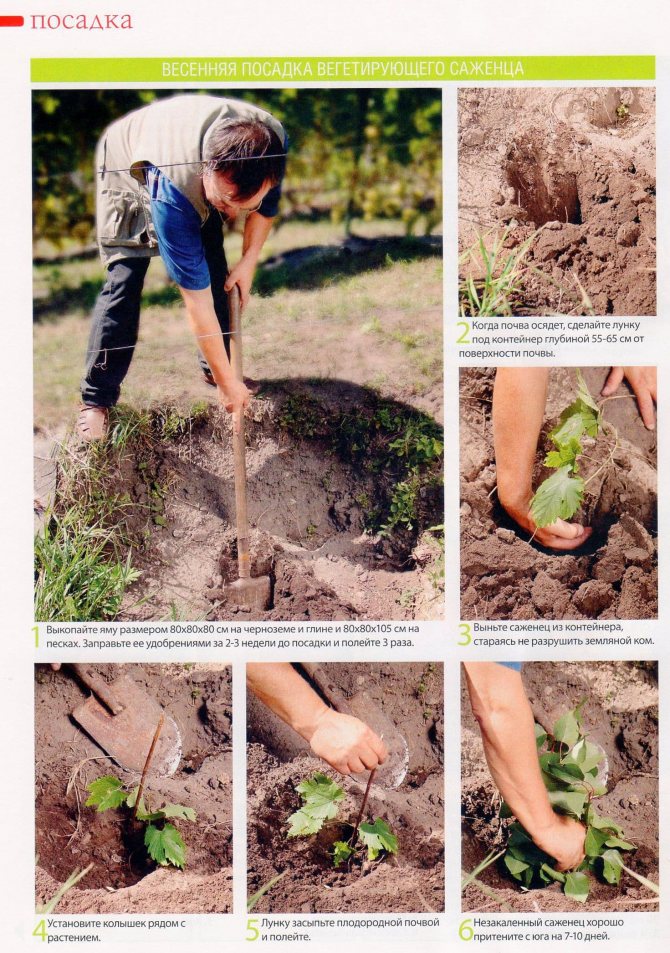

Grapes are especially whimsical in the first year after planting, so proper care is needed.
Soil preparation
The first thing to do when preparing the soil for planting grape seedlings is to remove weeds, stones and other debris on it. If there are pits, depressions in the selected area, then they should be covered with fertile soil. Next, you need to fertilize. It can be rotted manure, scattered in a layer of 5–10 cm. Then the site is dug up.
If the soil is heavy and clayey, it is necessary to loosen it, having achieved good passability for water and air. During plowing, small pebbles are introduced into the soil. Very fine granite is perfect for these purposes. To determine the texture of the soil, you can use simple methods to apply the necessary fertilizers. Take a lump of soil in your hand and pay attention to its consistency:
The earth is loose with practically no lumps - loose sandy; Loose lumps that disintegrate when lightly squeezed with their fingers - sandy; Dense lumps do not disintegrate - loamy; Lumps of earth are very dense when cut with a shovel, they begin to shine - clay.


Second way. Take some soil and soak until dough. Try to roll it into a ball. If a:
The ball turns out to be even, and the hands remain clean - loose sand; It is not possible to roll the ball and hands are smeared with soil - sandy; The ball rolls down, but at the lightest touch, it disintegrates - loamy; The earth is so plastic that you can roll a ring out of it - clay.
In these simple ways, you can determine the type of soil in order to know what fertilizer to add to improve its composition.
Installation of irrigation systems
Timely watering of grape bushes is a serious process in the agricultural technology of their cultivation. With a lack of moisture, nutrients are poorly absorbed by the plant. As a result, the grapes grow poorly, the berries are substandard, and the yields are reduced. When it rains often, it also has a bad effect on the plants. Varieties that are not resistant to fungal diseases begin to hurt and may even die from excessive moisture. Ripening berries crack, and the bunches become completely unsuitable for storage, even for a short period. Hence the conclusion: artificial sprinkling irrigation will not work.


The grapes are watered only in those ways when water, penetrating into the soil, immediately goes to the roots, and the stem, vines and leaves remain dry.
At this time, there are several ways to deliver life-giving moisture to a plant:
- Drip irrigation.
- In the ditches under the bushes.
- In the holes next to the bush and others.
Drip irrigation is a stretched tube with droppers through which water is supplied. In the drip irrigation system there are containers in which the water is heated and various fertilizers and fertilizers for plants can be added to it. Tubes in this moisture supply system can pass both along the ground and be attached to the first wire of the trellis. Drip irrigation is very efficient, but quite expensive to buy and install.
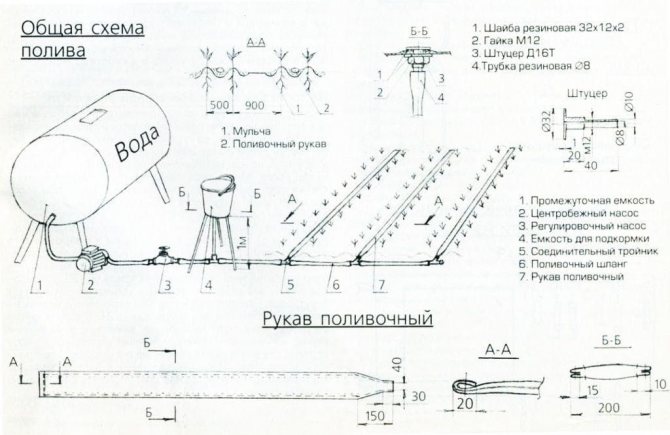

The easiest way to water your vineyards is to feed water into the grooves and pits near the bush. Depressions near the plant are made both temporary and stationary. During irrigation, fertilizers and top dressing can be applied to the furrows and grooves. This irrigation method is simple, but the water consumption is much higher than with drip irrigation. This method is also quite time consuming.
There is also an underground way of watering grapes. In this system, water is directed into the deep layers of the soil.
Preparing planting holes
For planting grape seedlings, it is necessary to prepare pits. 80 cm deep and 1 m wide. The pits are prepared in advance so that the soil at a depth has time to warm up. Several buckets of rotted manure are poured into the groove for laying the seedling. Then add a little sand and fine gravel, fertilize with ash from burnt wood, superphosphate and mix everything. The contents of the pit are slightly compacted and humus is added again with the right amount of fertile soil. You can read what soil grapes like here.
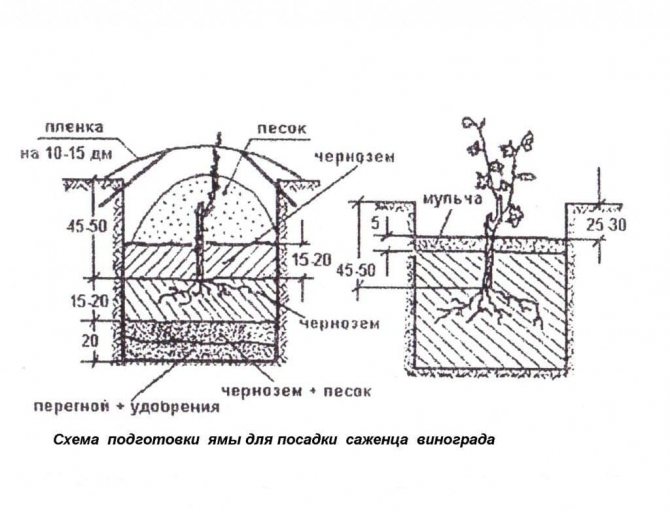

Sand and fine gravel are added in order to improve the aeration of the soil, as well as the permeability of water into it. This will be especially effective in areas with heavy loamy soils. Read about planting and caring for grapes in the open field in this material.
After carrying out all the work, the pit should be filled up to three quarters of its volume.
Planting materials
For planting seedlings, the following materials are needed:
- Good quality germinated and healthy seedlings.
- Sand, crushed stone for soil aeration, rotted manure, ash from burnt wood and superphosphate.
- Wire, concrete or metal supports for installing trellises.
- Water for watering plants, high-quality agricultural tools.
Autumn planting of grape cuttings is described here.
Step-by-step process
To plant grapes on a personal plot, you must:
- In the autumn, prepare high-quality and healthy cuttings for storage until spring.
- Fertilize the soil with rotted manure, planting.
- In winter, once a month, sort and examine the cuttings for mold.
- In the spring, sort out the planting material, reject the one that did not survive the winter.
- Engage in pre-planting and germination.
- After the roots appear and the buds open, prepare the seedlings for planting in open ground.
- Prepare the territory. Remove weeds, dig up, fertilize.
- Make a markup on the site, dig holes for planting.
- Plant and water the seedlings.
- Install the supports and tension the wire.
Major mistakes
The most common mistakes will be discussed below, familiarization with them will allow you to observe the correct landing technology:
- The initial purchase of planting stock is too low quality. Acquisition of cuttings in proven places will help to avoid such problems, it is best to do this in specialized institutes and nurseries or from professional breeders.
- Violation of the storage process, which leads to drying out or decay of the cuttings. To prevent this from happening, it is necessary to create the necessary microclimatic conditions for the planting material, the requirements for each variety may be individual.
- Too active and frequent use of various purchased growth stimulants can harm young grapes, especially if the permissible dosages are not observed, which are indicated in the instructions for all such products.
- The violation of rooting technology in most cases consists in the incorrectly chosen planting dates. It is necessary to focus both on the current weather conditions and on the stage of development of germinated cuttings.
Planting time
For planting grapes with cuttings without roots, unlike planting already rooted seedlings, autumn is not suitable, since the vine will not have time to take root and gain strength for the upcoming wintering. The only time to plant the shanks is spring.
The term for grafting depends on the climatic characteristics of a particular region taken, therefore, they are guided by an increase in temperature. The optimal time to plant seedlings without roots is the period when the soil warms up to a depth of 0.25-0.3 m to 10 ° C and above. This time is:
- in the southern regions - at the end of March - mid-April,
- in the central region - in early April-early May,
- in the northern districts - at the end of April and the last days of May.
Planting unrooted cuttings justifies itself when there is no risk of sudden frosts, otherwise seedlings without formed roots will die.
How to care after landing
After planting the cutting, the ground around it is tamped. The resulting furrows are well watered and covered with earth again to the required level. If the planting material was not waxed before planting, and the weather is dry, before the first shoots appear, the seedlings are constantly earthing up. At the same time, the school is watered abundantly.
Watering dates are determined based on the weather. If the weather is hot, then watering is carried out regularly. After watering, the soil must be loosened. The procedure is carried out without turning the earth lumps.
To avoid rapid evaporation of moisture, the ground around the bushes must be covered with straw. Weeds are also periodically weeded.
To protect plantings from diseases, plants are sprayed with a weak solution of Bordeaux liquid (1%). The procedure for removing the root superficial growth is periodically performed.


Protecting growing grapes from pests
Depending on the soil parameters, the frequency and type of fertilizing are selected. It is especially important to feed the grapes in the spring, when the bushes are entering the stage of active growth. In autumn, plantings are also fertilized to prepare plants for wintering. For the winter, young plants must take shelter.
If the planting of grapes was carried out correctly, then the chances of survival of the cuttings will increase significantly.
The most important years in the cultivation of this crop are the first 2-3 years of the seedlings' life. During this period, the formation of the shape of the bush takes place. Therefore, periodically shoots with a length of more than 5-8 cm break off. 1-2 shoots remain on the remaining vine.
The choice of planting material
The correct choice of variety will help to grow a healthy vine, with stable and abundant fruiting for more than a dozen years. They are guided, first of all, by personal taste preferences and climatic adaptability of the culture, comparable to local conditions.


Grapes are cultivated in two ways: seed and vegetative. The first option is used primarily by breeders seeking to develop new varieties. For private cultivation, the second option is suitable, implying reproduction:
- cuttings;
- layering;
- vaccination.
This article will consider the aspect of when and how to plant grapes with cuttings in the fall. And you can find out in more detail how to prepare and preserve the shanks cut in the fall until spring, here.
Vegetative cultivation of grapes makes it possible to preserve the original varietal characteristics in the newly obtained vine in full. This is due to the high regenerative capabilities of the plant, as regards all its parts. The grape vine endures winter staunchly, quickly recovers even with freezing, without damage to fruiting.
But it is possible to grow young bushes only from a part of the shoot, on which live buds are present. The material is harvested according to a certain method, which should be followed. Cuttings are taken only from healthy and well-developed grape plantings, over the age of 2 years, with a vine length of at least 1.3 m and a thickness of 5-10 mm. When it is bent, a slight crack should be heard.
Diseases and methods of their treatment
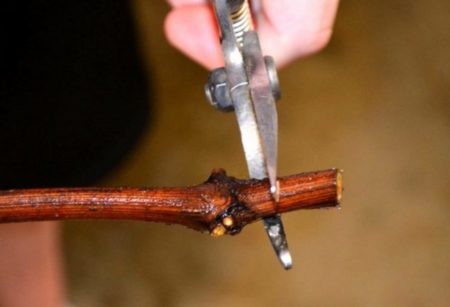

It is possible to get healthy grape seedlings only with proper and complete care. It is important to use healthy bushes not affected by fungal infections for cutting.
In order to avoid diseases, cuttings are processed before laying for winter storage, as well as before planting in pots. Suitable drugs:
- foundation;
- rovral.
Some gardeners treat cut cuttings with pink potassium permanganate solution. Treatment with drugs will protect the planting material from dangerous microorganisms, avoid the occurrence of foci of the disease during storage.
For the same purpose, during germination, activated carbon and wood ash are added to the water with cuttings. If the cuttings are germinated in a substrate of sawdust, then it is useful to spray them with Rovral's solution once a week.
When growing grapes from cuttings, observe the leaves. If the leaf blades begin to change color, turn yellow, this is a signal of the possible appearance of a dangerous mildew infection. Promptly prepare Bordeaux mixture and process the cuttings. Instead of Bordeaux liquid, you can use the drug Ridomil Gold.
With waterlogged soil or lack of moisture, the leaves turn black. The same happens in situations where the soil for the seedlings is incorrectly selected (too dense structure). Exit: immediately change the soil in the pots, adjust the watering regime of the plants.
Care of grape seedlings after autumn planting
They begin to look after the shanks planted in the open ground in the fall in the spring:
- after the snow melts, insulation materials (earth, peat, spruce branches) are removed;
- water thoroughly;
- shade from the sun.
One way to shelter young plantings from the sun and spring frosts is to make a greenhouse over them or put an arch made of non-woven material.
Interesting! When using plastic bottles, a number of gardeners do not remove them in the spring until leaves develop on the seedlings. Others, on the contrary, remove such insulation along with others.


The methods considered in the article differ from standard cultivation in that they require less time and labor costs: there is no need to store blanks, check their condition, germinate in containers, etc. However, it should be borne in mind that the autumn planting does not give 100% survival rate of cuttings. Therefore, to obtain the required number of seedlings, the number of shanks is taken with a margin.
If the gardener, having cut the cuttings, did not manage to plant in the fall, he can remove the prepared material for storage in a cellar or refrigerator and germinate it in the traditional way in February.
Caring for planted grapes before winter
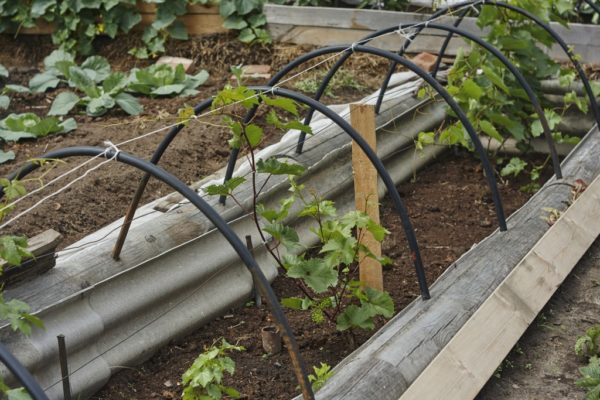

It is important to care for the planted grapes before the onset of winter and insulate them to protect them from frost
Caring for seedlings and cuttings consists of watering and loosening the soil. Young plants do not need fertilizing.
With the onset of a persistent cold snap, the surface under the plantings is mulched with dry grass, hay, sawdust, humus. The height of the layer is 10–15 cm.
In anticipation of frost, the vineyard is covered with agrofibre, placing it on the established frames. One of the options for shelters is to install roofing material with a house. This option of insulation will reliably protect the grapes from the cold and prevent damage to the shoots.
conclusions
- Grapes are grown with such planting material: grafted seedlings, seeds, cuttings, root shoots and layering.
- You will have to buy grafted seedlings only in the nursery, if the grower does not know how to do the grafting operation on his own.
The most popular and cheapest methods are to grow their own rooted ones, which can be obtained from such material:
- Cuttings. It is harvested from the vine of the desired grape variety, cutting into 35-70 cm in length. It is best to propagate grape cuttings in the spring.
- Layers. A perennial branch is selected from the mother bush, placed in a long hole and buried in the ground. Only the upper part of the vine with two buds remains on the surface of the earth.
- Root shoots... A piece is cut off from the rhizome and buried in the ground, after fertilizing and watering the trench.
Why is this option the most effective?
The vine can be propagated in many ways, but best of all, the material takes root, rooted from ripe cuttings. The technique is simple and gives good results. A strong and fruiting bush subsequently grows from the cuttings.
The planting material quickly takes root, it takes root in a new place without problems. Cuttings are able to fully preserve the pedigree of vegetation, which gives a significant advantage to this method of propagation of grapes. How and when to properly propagate grapes by cuttings to obtain a good harvest, we will consider further.
Cutting grapes on the window
Some gardeners plant cuttings on the windowsill at home. For this, the fertilized soil is poured into a plastic bottle cut from the top. And they leave it for a while to "charge" with solar energy in the light. Shoots are poured with water, covering only 1 peephole of the base.
The vessel is infused for a long time, roots begin to hatch in late autumn. Then only the cuttings must be planted in prepared containers with soil. The substrate must be loose. It is better to purchase ready-made soil in a gardening store, filled with the necessary composition of micro and macro elements.
Fertilizers
Grape planting material, like any other vegetation, needs additional feeding. Especially at the stage of root formation. The vine prefers granular superphosphate as a fertilizer. It also does not interfere with cuttings, but in a dissolved form.
For better root formation, you can use mineral complexes, which include a nitrogenous substance - 2 g, phosphate - 2.5 g, potassium fertilizer - 2 g. The components are dissolved in 5 liters of water. After 14 days, the procedure is repeated.
Gardening tips
Summing up, you can give the following tips for growing and propagating grapes, which were given by experienced gardeners:
- During the first 2-3 years, all grape varieties, even with sufficient frost resistance, it is necessary to organize a high-quality shelter for the winter.
- During the spring thaw, it is not recommended to immediately carry out a complete dismantling of the shelter., it can still come in handy in case of frost.
- It is recommended to keep a special diary, which will record the timing of germination., landing and other nuances, which will not allow you to accidentally get out of schedule and disrupt the technology.
- Supports for future vines are recommended to be erected in advance near the planting site, since a heavily overgrown bush will interfere with the construction process.
Choosing a plot for a vineyard
It is advisable to choose a site for a vineyard in the summer in order to prepare the soil for planting, apply fertilizers, prepare trellises or greenhouses for the autumn planting of grapes by cuttings.
To make the grape harvest pleasantly happy every year, you need to choose the right place for planting:
- the place should be on the sunny side, protected from strong winds;
- it is advisable to allocate the site away from irrigated crops and the old vineyard, in the land of which pests and painful spores could remain;
- place the trellises in a straight line "north-south" so that the bushes are illuminated by the sun all day;
- the vine must be ventilated, so it is worth planting it at a considerable distance from trees and other shrubs.
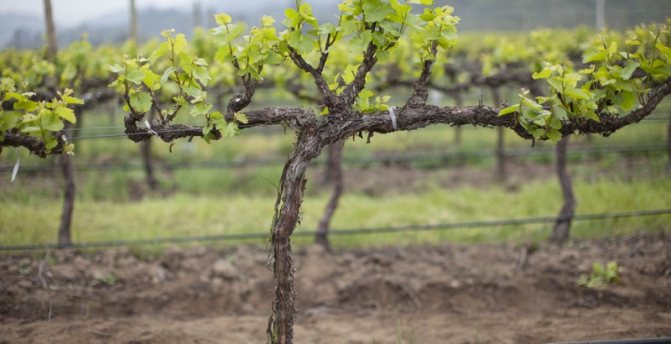

Grapes are considered an unpretentious shrub that grows in any soil, even rocky ones. He does not like a lot of water: the roots in such soil receive less oxygen, rot and die. Therefore, it is worth choosing a place where the groundwater is at the level of three meters and deeper.
The soil is preferable fertile, light, not containing much moisture. If the soil is heavy, sand, compost, and fine gravel are added. On wetlands, it is necessary to first drain and raise the area higher.
A place for a vineyard is prepared in the summer, fertilizing and watering well, because without this, it will be impossible to plant grapes with cuttings in autumn. Without sufficient amounts of trace elements, minerals and microorganisms, they may not take root.


